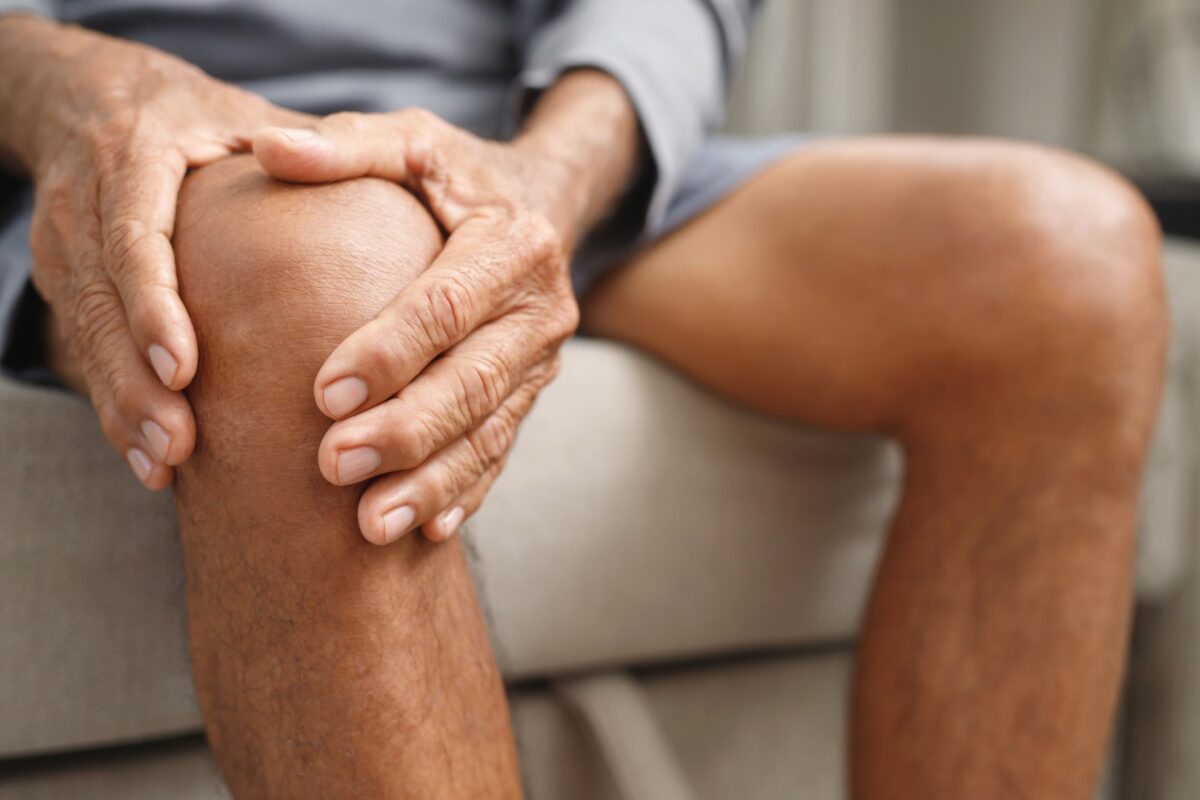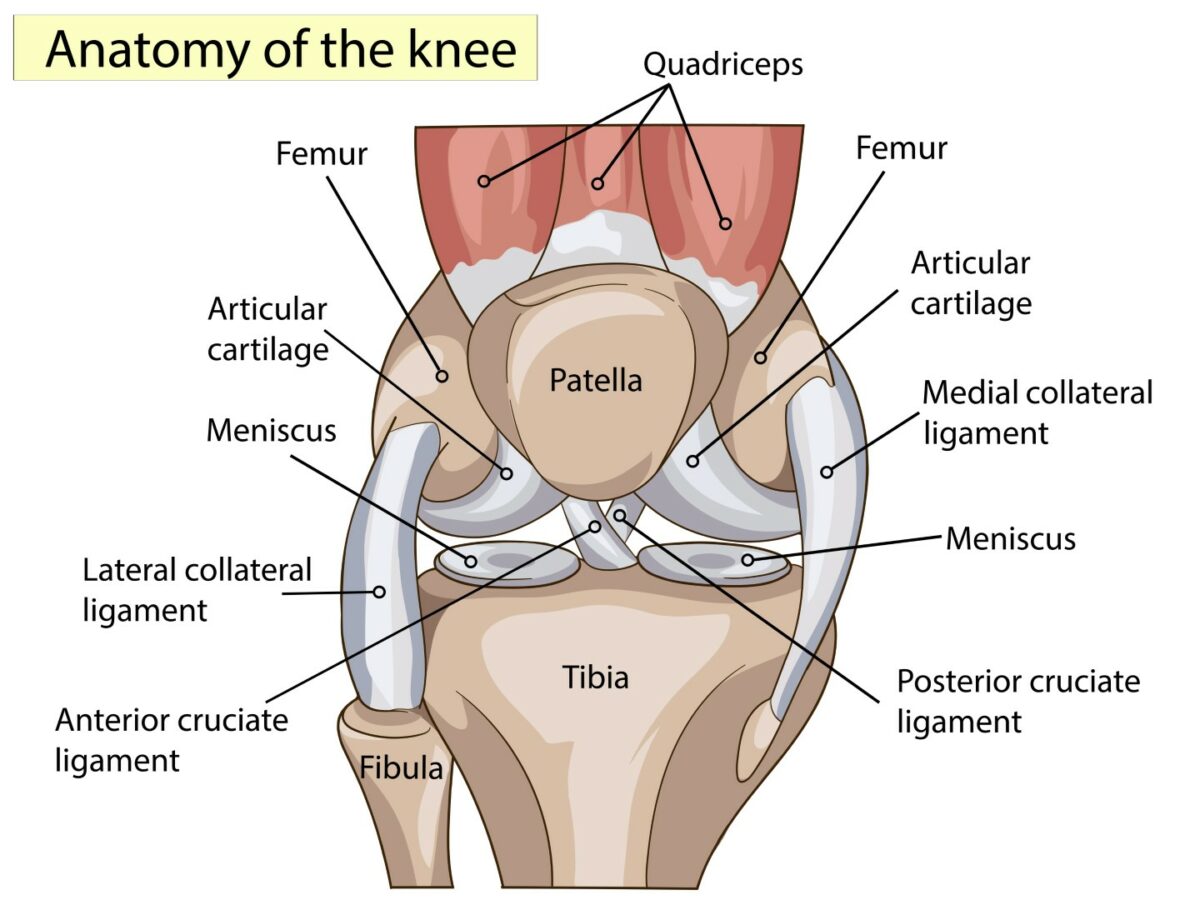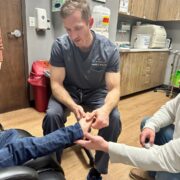
Ever wonder, “Why does my knee hurt when I climb stairs or bend down?” You are not alone! Your knee is the largest joint in your body—one that is susceptible to several common knee injuries and conditions that can cause pain and weakness, ranging from acute trauma to chronic conditions. Pinpointing the exact cause of your knee pain, where it hurts, when it flares up, and the nature of the discomfort can go a long way in getting relief.
Brief Anatomy of Your Knee
 To understand what may be causing your knee problem, it is helpful to understand the anatomy of the knee and how it works. A healthy knee bends easily and rotates slightly. The joint absorbs stress and moves smoothly, enabling you to walk, squat, twist, and turn without pain.
To understand what may be causing your knee problem, it is helpful to understand the anatomy of the knee and how it works. A healthy knee bends easily and rotates slightly. The joint absorbs stress and moves smoothly, enabling you to walk, squat, twist, and turn without pain.
The knee is a hinge joint, formed where the thigh bone and the shinbone meet. The joint is covered with smooth tissue and powered by large muscles. When all the following parts are healthy, a knee should move easily:
- Cartilage is a layer of smooth tissue. It covers the ends of the thigh bone and shinbone, and lines the back side of the kneecap.
- Muscles power the knee and leg for movement.
- Tendons attach the muscles to the bones.
- Ligaments, including your LCL, MCL, ACL, and PCL, are bands of tissue that connect bones and brace the joint.
- Bones that make up your knee joint include your thigh bone, shinbone, and kneecap.
- Menisci are two wedge-shaped pieces of cartilage that absorb shock between the thigh bone and shinbone.
When any part of the knee joint becomes unhealthy, pain, weakness, and dysfunction can occur.
Where Does Your Knee Hurt?
Many common knee injuries and conditions can be diagnosed based on the location of your pain.
Front of the Knee
Pain at the front of the knee, or anterior knee pain, can be a sign of several conditions:
- Patellar tendinitis: An overuse injury causing inflammation of the tendon connecting your kneecap to your shinbone
- Chondromalacia patella: Also known as “runner’s knee,” this refers to the softening and breakdown of the cartilage on the underside of the kneecap
- Patellofemoral pain syndrome: Discomfort around the kneecap often related to activities like running, squatting, and jumping
- Arthritis: Wear and tear of the ligaments can cause pain in the front of the knee, side of the knee, or all around the knee
Inside or Medial Side of the Knee
Pain on the inner side of the knee might indicate:
- Medial collateral ligament (MCL) injury: Often caused by a blow to the outer side of the knee
- Medial meniscus tear: A tear in the cartilage on the inside of the knee, common in sports that involve twisting movements
Back of the Knee
Pain at the back of the knee could point toward:
- Baker’s cyst: A fluid-filled swelling behind the knee that can cause a sensation of fullness or tightness
- Hamstring tendinitis: Inflammation of the tendons that attach the muscles of the back of the thigh to the knee.
Understanding Your Symptoms
Certain symptoms can also point to common knee injuries and conditions, such as:
- Swelling and stiffness: Indicates inflammation and could be due to conditions like arthritis or bursitis
- Popping or crunching noises: Could suggest cartilage damage or a meniscal tear
- Weakness or instability: Often a sign of a ligament injury, making the knee feel like it will “give out”
- Inability to fully straighten the knee: May be due to a meniscus injury or severe inflammation
Treating Knee Pain: From Home Remedies to Professional Care
Some of the most common knee injuries can be improved or corrected with the following methods:
- RICE Method: Rest, ice, compression, and elevation can help in the initial phase after an injury.
- Over-the-counter medication: Anti-inflammatory drugs can help alleviate pain and reduce swelling,
- Professional Interventions: If your knee pain persists, it might be time to see a specialist. Treatments provided by an orthopedic specialist may include:
- Physical Therapy: To strengthen the muscles around the knee and improve flexibility
- Steroid Injections: To reduce inflammation and pain
- Surgery: In cases of severe injuries, such as ligament tears or significant meniscus damage, surgical intervention may be necessary to restore function.
Preventing Knee Injuries
Orthopedists recommend several things you can do to help prevent some of the more common knee injuries, including:
- Strength training: Building muscle support around the knee can protect it from injury.
- Flexibility: Stretching exercises can maintain or improve range of motion and flexibility, reducing the risk of injuries.
- Proper footwear: Shoes that provide good support can lessen the strain on your knees.
Do not let knee pain keep you on the sidelines. The knee specialists at EmergeOrtho—Foothills Region are board-certified or board-eligible and fellowship-trained in all injuries, conditions, and nonsurgical and surgical treatments related to the knee joint. If knee pain is slowing you down, request an appointment here and let us help you Emerge Stronger. Healthier. Better.







